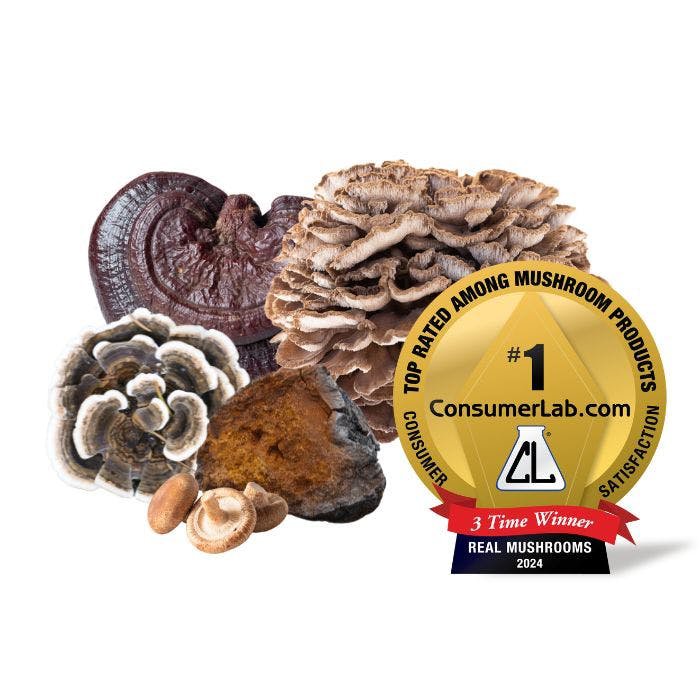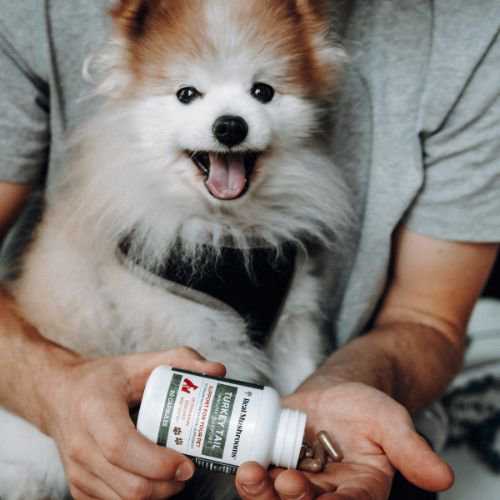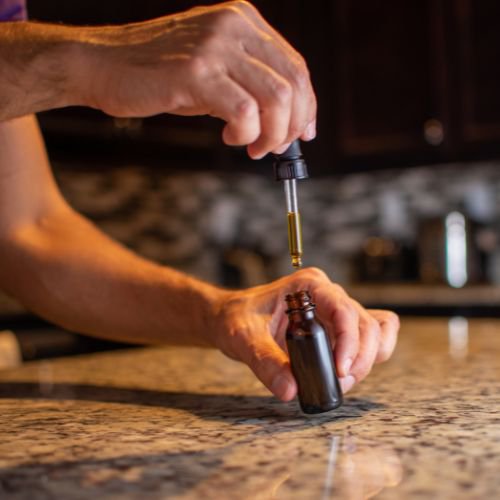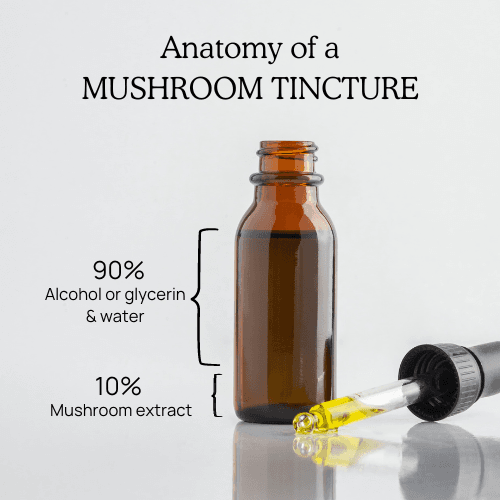Menu


Have you decided it's time to add some mushroom supplements to your pet’s daily regimen? Maybe you've heard of the incredible immune-supporting benefits that daily use can bring. Or maybe your pet has a health issue, and your pet healthcare provider suggested mushroom extracts as a supportive addition to their health protocol.
Regardless of the reason for starting our furry family member on mushrooms, we want to choose the best quality mushroom product. We also want our pets to take the supplements readily without it being a struggle.
This is where things can get very confusing. There are so many different mushroom products in the marketplace and various delivery methods. Which one is best? Is there a definitive way to determine the quality of a mushroom product?
This blog will give a general overview of mushroom powders & liquid tinctures, and key factors to consider when choosing a mushroom product for your pet. Part 2 of this blog will dive deeper into extraction techniques, how to read a label, the mycelium on grain issue, and more.
The most important factor, regardless of what type of product you decide to order, is that you are getting a high-quality mushroom product. Beware of companies that have incredible marketing, but that don't back up their claims with facts.
For instance, the “Consumer Reports” of supplements, ConsumerLab, has chosen Real Mushrooms as their top mushroom supplement for the last 3 years in a row. They are an authority in lab testing supplements for quality.

ConsumerLab.com publishes the results of its tests in comprehensive Product Review reports at www.consumerlab.com for its members. We are honored that ConsumerLab continues to validate the quality of our products.
Additionally, Real Mushrooms is a National Animal Supplement Council member and our bottles will soon bear the NASC quality seal.
To earn permission to display the NASC Quality Seal on its products and marketing materials, an NASC member company must do the following:
Let’s explore the key points in determining whether you are getting a quality mushroom product or whether you should look elsewhere:
Mushroom products must be tested—ideally by a third party—to confirm they do not have contaminants and heavy metals. This means an independent company not affiliated with the product does the testing.
As an example, here is a sampling of the testing that Real Mushrooms does:
If you would like to dive deeper into our testing procedures, here is an article from our mushroom supplier, NAMMEX: https://www.nammex.com/mushroom-quality-control/
Found in the cell walls of fungi, beta-glucans have garnered the most attention in relation to mushroom benefits with over 20,000 published studies (including yeast beta-glucans). Beta-glucans are immunomodulating, anti-inflammatory, neuroprotective, anti-viral, anti-neoplastic, microbiome-supporting, and so much more.
Beta-glucan (BG) levels in a product are a good determinant of quality and potency because they can be verified through testing. Real Mushrooms has guaranteed BG content listed on every product.
Ensure that your mushroom product lists the percentage of beta-glucans on its product label to help you identify quality and potency.
Now let’s look at the different “delivery methods” of mushroom supplements. The most common mushroom offerings for pets in the marketplace today are extract powders & liquid tinctures. The powders are often enclosed in capsules.
I interviewed several colleagues who are herbal medicine practitioners and who create tinctures and asked a LOT of questions. I am grateful for the time they shared with me, although I must say, I was left with more questions than when I started.
Since I have access to an amazing team of researchers, scientists, and mushroom growers, I could take my questions to them. With over 30 years of research & development in the mushroom supplement industry, I was curious about why our company wasn’t making tinctures. The short answer is this: after much experimentation, it became apparent that no liquid tincture could be as potent as powdered mushroom extracts. Read on as I dive into the details…

An important distinction about mushroom extract powders, or at least those that are of high quality, is that they are not just ground-up mushrooms. It’s also important to distinguish between a mushroom extract powder and a myceliated grain (MOG) powder.
This blog focuses on mushroom extract powder. More info on powders containing mycelium on grain can be found here: https://www.realmushrooms.com/medicinal-mushroom-benefits-fruiting-body-vs-mycelium/
A quality mushroom supplement is created by sending the mushrooms through an extraction process before being turned into a powder. The extraction process utilizes boiling water and sometimes ethanol to remove all the soluble function constituents from the dry mushroom. This ensures the beneficial elements of the mushroom are available for the body to use.
For more details about mushroom extraction, read our blog: https://www.realmushrooms.com/mushroom-extraction/
Real Mushrooms founder and CEO, Skye Chilton, states, “Think of an extract powder as a liquid extract without the solvents. It exists as a liquid at one stage during the extraction process, then by using a spray dryer all the moisture is evaporated. You’re left with the final extract powder. No water or alcohol. Just concentrated mushrooms.”
There is a lot of misinformation about the bioavailability of mushroom powders. Some tincture companies are marketing themselves as more bioavailable. This is simply not true. The reality is that powders are highly bioavailable, and it has to do with how the body processes mushrooms.
Here are the facts as noted by Medical Herbalist Lee Carroll. Lee recently joined Real Mushrooms as our Chief Medical Herbalist. Lee is a natural at interpreting information from the cutting edge and making it accessible and relevant to you, the consumer. He also has a mushroom education course focused on training practitioners and educators.
We are delighted to announce that Lee Carroll has been chosen to lecture about mushrooms at the American Holistic Veterinary Medical Association’s (AHVMA) annual conference this year.
Lee outlined the basics about the bioavailability of mushroom extract powders:
Says Skye Chilton, “There are claims of tinctures having better absorption via the mouth (this may be true for other plant molecules) but most of these fungal molecules are absorbed by or interact in our intestine. Ultimately, you can just take an extract powder and dilute it in water and alcohol to make your own tincture.”
The short answer is no. Over the past year, I have seen a distinct uptick in the misinformation regarding this topic. FDA Dietary Supplements are required to meet 100% of their label claims at the expiration date. The claims are confirmed by stability testing which is either done through accelerated stability testing in an incubation chamber, or through real-time testing. At each testing interval, the safety and any of the label claims the product makes are verified.
At Real Mushrooms, we are moving to a 3-year “best before” date, which is a longer timeline than our previous labeling. This update comes after having conducted stability testing for our products that confirm they are stable for 3 years and beyond. These studies prove that the process of degradation from exposure to air, heat, and time is a very slow one for the mushroom extract powders.
Beta-glucans are inherently stable molecules, however, over time they can be affected by exposure to sunlight, temperature, and moisture. We use packaging that protects the product from light for this reason. Therefore, we recommend always storing your mushroom products below 86 F, and keeping the product in its original container with the lid on (or pouch sealed). This general recommendation would apply to any supplement, not just mushrooms.
This is a somewhat complicated question as the word “tincture” is often misused in the world of mushroom supplements. To get a clearer picture, I asked Lee Carroll to help break things down for me.

It’s imperative to know the indicators of quality when it comes to mushroom products in general, but even more so when it comes to tinctures. Why? Because they are so easy to manufacture and offer attractive profit margins. Therefore, many companies enter the tincture market with little accountability for delivering quality and potency.
Lee Carroll explains:
“I recommend caution when using liquid extracts. Liquid extracts are relatively straightforward to manufacture and allow companies easy access to the market. I think this is one of the reasons why we are seeing so many liquids on shelves.”
Several considerations must be made to identify a quality liquid product:
Most significantly, there are no validated test methods for beta-glucans in a liquid at present. So, there is no way to measure the levels of this all-important mushroom compound in tinctures/liquid extracts.
Technically, it’s possible to make a good liquid extract, however, as Lee states, “It’s much safer to stay with dry extracts and reputable manufacturers.”
The biggest challenge with tinctures is that the potency cannot be determined with current testing methods. How can we know what is actually in that bottle? As the beta-glucans are the important polysaccharide in these fungi, it is vital that beta-glucan testing be done to qualify medicinal mushroom products.
The Megazyme Method, developed by Dr. Barry McCleary at Megazyme International, has been used by the USDA and other peer-reviewed research papers to precisely measure the beta-glucan and alpha-glucan content in mushrooms. It can test all types of basidiomycete products like mushroom powders, mushroom extracts, and mycelium powders. It detects soluble and insoluble (1-3)(1-6)beta-D-glucans and even quantifies the alpha-glucans, which include starches, so we can see if products contain fillers like grain (1). Unfortunately, this test doesn’t work for liquid tinctures. There is currently no approved method for testing beta-glucans in liquid tinctures.
Says Lee Carroll,
“If liquid products make outlandish beta glucan claims — I have seen claims of beta-glucans levels as high as 50%
—then you can use your reason to test this claim: if a liquid has 50% of something dissolved into it, it will change the viscosity and make it feel thick. Many of these mushroom liquid extracts are very thin and don’t have strong tastes.”
The weaker the tincture the more the consumer needs to take to get an effective dose. So effective products are always made as strong as possible to minimize the dose.
Quality liquid mushroom products should ideally be made as 1:1 liquid extracts. This ratio describes the product strength and means every milliliter (mL) of product is equivalent to 1,000 mg (1 g) of mushroom. Liquid products typically have a lot less mushroom in them than this e.g. 350 mg per ml. So it’s important to carefully read the labels (3).
Functional mushrooms contain between 1 and 3% soluble beta-glucans. So a 1:1 liquid extract could only have a maximum of 1 to 3% beta-glucans. If a liquid tincture is listing a beta-glucan content higher than this on the bottle, ask the company how that is possible and how they determined that amount. Ask for a certificate of analysis.
By the nature of tinctures being a liquid, they have 90%+ moisture content. This is usually composed of water and alcohol. 30-40% alcohol is required to make them shelf-stable. While alcohol in very small amounts is tolerated by dogs and cats, veterinary tinctures will often use glycerin instead of alcohol. Glycerin is more palatable and also adds a sweet taste to the product. As a stabilizer, glycerin is required in higher amounts, making up over 50% of the product. Roughly 90% of the product is glycerin and water, leaving <10% for active fungal compounds.
For more information on glycerin in veterinary products, I turned to the “gold standard” of resources, Veterinary Herbal Medicine. Written by Dr. Barbara Fougere and Dr. Susan Wynn, this book is treasured by veterinary herbalists and integrative DVMs. It has been a desktop staple of mine for over a decade. Dr. Fougere will be speaking at the International Healthy Pets Experience hosted by Dr. Judy Morgan!
Drs. Fougere & Wynn explain:
“Glycerites ideally should be kept capped and refrigerated because they can mold. Glycerin tinctures must consist of more than 55% pure glycerin if they are to have preservative capacity (vegetable glycerin contains 5% water, which must be factored into the calculation).”
One limitation of glycerin tinctures is the potential for microbial contamination, especially from fresh plant starting material (4).
If stored properly in a cool, dark place, glycerites made with no alcohol have a shelf life of approximately 1-2 years (compared to 4-6 years for alcohol-based tinctures).
Lee Carroll mentions another issue with tincture potency:
“Liquid extracts are typically less concentrated than the starting material. For example, 1 gram of mushroom might make 5 mL of extract. Therefore, if you want an effective dose of lion’s mane, say 3 grams, then the daily dose of liquid extract would be 15 ml. Typically, these liquid products are recommended as drop doses and 15 mL is around 300 drops, multiple teaspoons, or more!”
Note that a 15 ml dose is roughly 2-4 servings, making these liquid tinctures very expensive for the consumer.

I sincerely hope that this overview has been helpful. I will close with this final thought: Enthusiasm about mushroom products is great, but it is so important to dig down to the facts. If you are depending on a mushroom product for the health of your pet, it matters if they are actually getting a therapeutic dose. Therefore, it matters that your product will be of therapeutic quality and potency.
If there are liquid tinctures on the market getting proven beta-glucan numbers with accepted methods, we welcome this new science. However, if a company makes claims about verification processes that are proprietary and deny the public and researchers the ability to replicate and confirm their findings, then how can these claims be validated?
Ultimately, as Lee Carroll always says, if we lose touch with quality and efficacy, the important role mushrooms play in pet (and human) health will be diminished as consumers buy products with great marketing and low potency and efficacy. If the products don’t work, the consumer thinks it's because mushrooms are just a “hype” and there is no real value to them. Then everybody suffers, especially our beloved pets.

2) McCleary, B. V., & Draga, A. (2016). Measurement of ß-Glucan in mushrooms and mycelial products. Journal of AOAC International, 99(2), 364–373.
3) Bone, K., & Mills, 2. (20133). Principles and Practice of Phytotherapy: Modern Herbal Medicine (2nd ed. pp. 121-133). Elsevier.
4) Barbara J. Fougère, Susan G. Wynn, in Veterinary Herbal Medicine, 2007 Glycerin Extracts, Glycerites, and Glycetracts, pg 225
Disclaimer: The information or products mentioned in this article are provided as information resources only, and are not to be used or relied on to diagnose, treat, cure, or prevent any disease. This information does not create any patient-doctor relationship, and should not be used as a substitute for professional diagnosis and treatment. The information is intended for health care professionals only. The statements made in this article have not been evaluated by the Food and Drug Administration. Any products mentioned are not intended to diagnose, treat, cure, or prevent any disease. The information in this article is intended for educational purposes. The information is not intended to replace medical advice offered by licensed medical physicians. Please consult your doctor or health practitioner for any medical advice.

– Plus, Enjoy Exclusive Tips and Updates with Our Real Mushrooms for Pets Newsletter